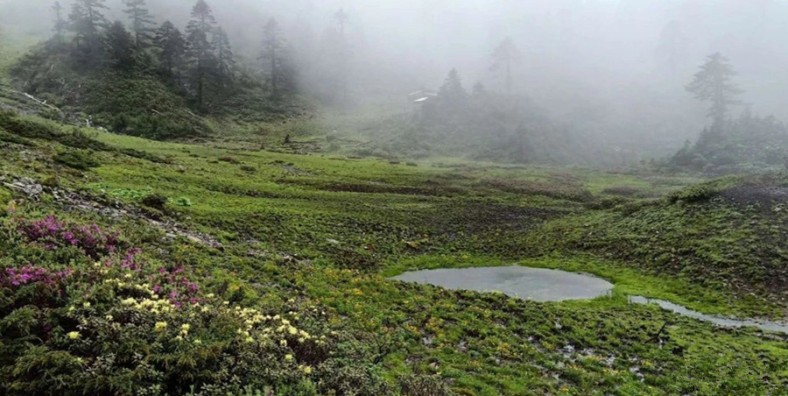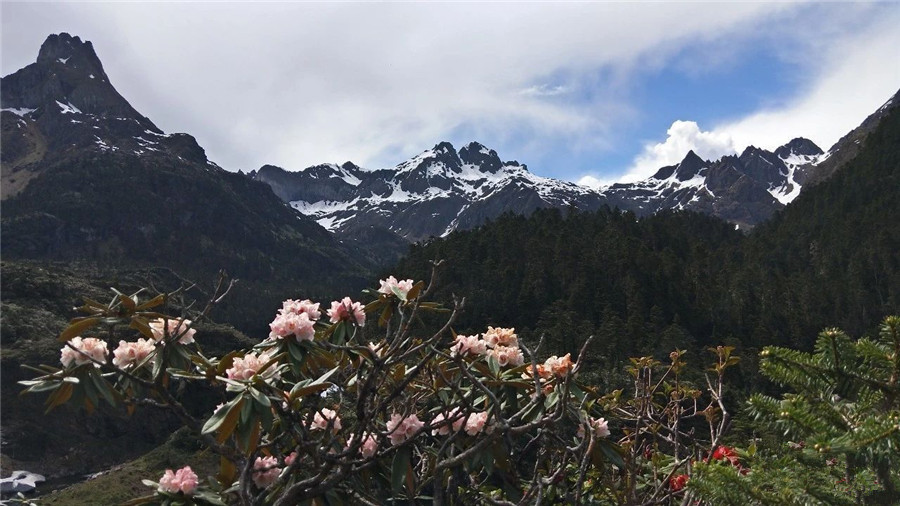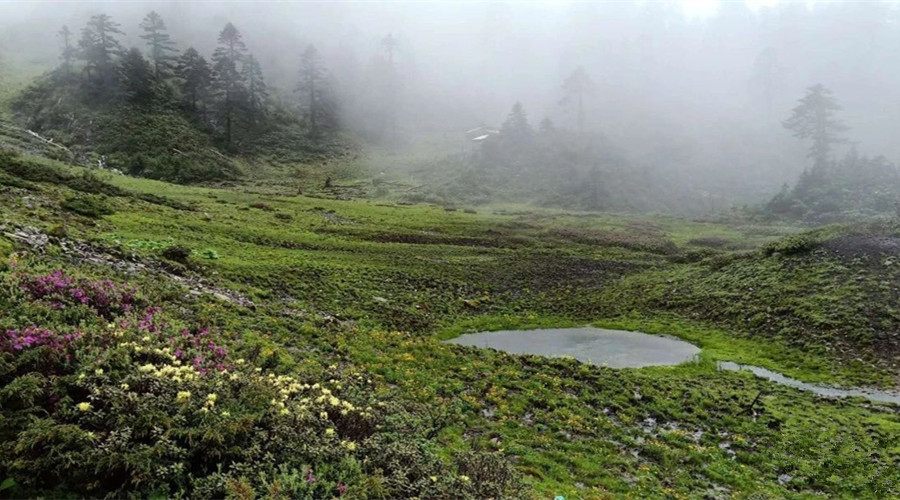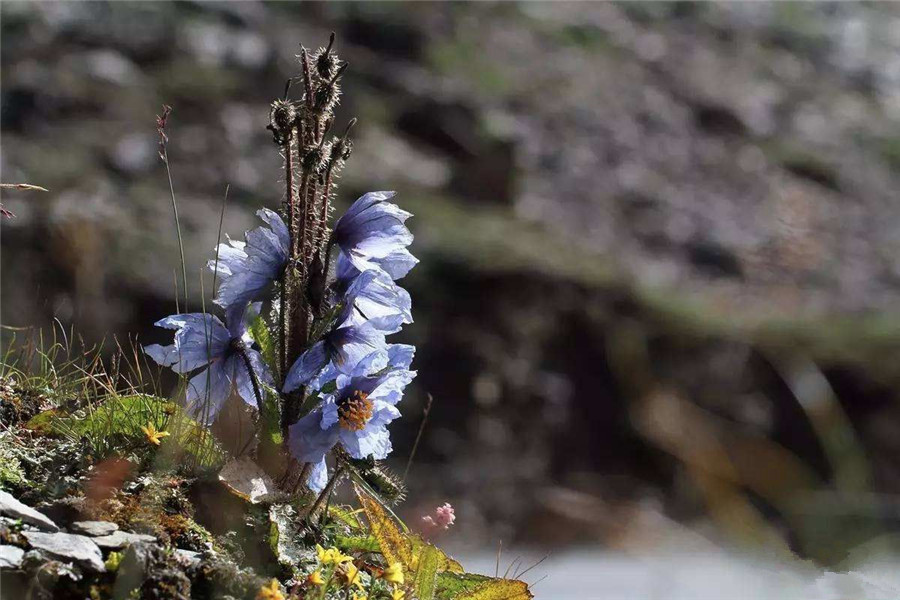
Jiuhu Yishan Scenic Area (Nanjiluo) in Weixi County, Diqing

English Name: Jiuhu Yishan (Nine Lake One Mountain) Scenic Area of Baimang Snow Mountain
Chinese Name: 白茫雪山九湖一山风景区
Attraction Type: Lake
Best Time to Visit: All the season
Recommended Visiting Time: 1 Day
Open Hours: All Day
Admission Fee: Free
Location: Weixi County, Diqing Tibetan Autonomous Prefecture of Yunnan Province
Why is Jiuhu Yishan Scenic Area So Special?
Jiuhu Yishan (Nine Lake One Mountain) Scenic Area of Baimang Snow Mountain in Weixi County, Diqing is famous for its nine lakes. Clear water and beautiful landscape attract a lot of tourists to visit. It abundants animal and plant resources. Tourists come here to admire flowers and view different animals.
Where is Jiuhu Yishan Scenic Area?
The group of alpine lakes in Jiuhu Yishan Scenic Area is located in Luotong Community, Luoyi Village, Badi Township, Weixi County, Diqing Tibetan Autonomous Prefecture. It is only 94 km away from Meili Snow Mountain.
The Nine Lakes and One Mountain, also known as Nanjiluo, is a term used by the Tibetan people to refer to the main peak, “Lengbugeqi” (in Tibetan), and the surrounding lakes. It is located in Lotong Village, Loyu Community, Badi Township, Weixi County, Diqing Prefecture, Yunnan Province, approximately a two-hour drive from both Deqin County and the Weixi County seat. The area has convenient transportation and abundant natural resources. The high-altitude lake clusters are situated in Lotong Village, Loyu Community, Badi Township, Weixi County, only 94 kilometers away from the famous Meili Snow Mountain.
Loyu Village is home to a diverse population, predominantly Lisu, with a minority of Han Chinese. This area serves as a boundary between Tibetan and Lisu communities, with the neighboring Deqin County mainly populated by Tibetans. Loyu Community is the only area fully inhabited by Tibetans, with 42 households and a total population of 220 people (as of 2013). The Loyu Community also has its five sacred mountains: Nyenchen Karwa Gebo, Nongbu Wuqi, Gongyi Luojiu, Diguzama, and Zhage Wubu.
There are many high-altitude lakes here, with nine that are most frequently mentioned in local folklore:
- Lojiuchuna (Black Lake)
- Lunaxing (Moon Lake)
- Xiezicuo (Wild Cat Lake)
- Chugei (White Lake)
- Yicuogume (Green Gemstone Lake)
- Lunnachugei (Another White Lake)
- Chumilu (Bright Gemstone Lake)
- Chugang – meaning a lake that sometimes disappears without a trace and occasionally reappears suddenly
- Zhahuichuna – the most mysterious lake, considered to have the temper of an evil spirit. Locals say it is an evil dragon, and if one speaks loudly near the lake or throws stones into it, the weather will change abruptly. Only two villagers, searching for lost cattle, have stumbled upon this lake, which adds to its mystery through many local legends.
Nanjiluo, also known as Nanjieluo, is located in Badi Township, Weixi County, within the Hengduan Mountains. It serves as a boundary line between Gongshan and Weixi counties and as the watershed between the Lancang River and the Nu River. The area is famous for its nine lakes and one sacred mountain. While referred to as nine lakes, there are actually more than a dozen high-altitude lakes and other main attractions, including snow-capped mountains, alpine meadows, virgin forests, waterfalls, and villages. Some have described this place as “the tears that God left behind on Earth.”
Within this region, there are 15 snow-capped mountains over 4,000 meters in altitude. The main peak, Nombu Geche, is 4,435 meters high. The area above 3,500 meters is characterized by grassy mountains and rocky terrain, while elevations between 2,800 to 3,500 meters feature coniferous forests with pine and fir trees, and below 2,800 meters are mixed forests and shrubs. The mountain climate is highly variable, with numerous waterfalls and clusters of high-altitude lakes. The core scenic area includes lake clusters above 3,800 meters, with the best viewing times being when rhododendrons bloom in May and June or in late autumn.

Ancient Legends
According to ancient Lisu myths, Nanjieluo was once covered only by snow mountains, forests, and meadows. One day, the mountain deity Kawagebo rode a tall horse from Swallow Cliff to the Meili Snow Mountain. As he passed through Nanjieluo, he stopped to water his horse. He accidentally dropped his prayer beads, which turned into the present-day lake clusters.
White Lake
A 30-minute hike from the pasture camp leads to the first lake, White Lake, known as Cuogai in Tibetan. This lake is considered benevolent and is the guardian deity of local livestock. Cattle, sheep, and horses can graze around here. Medicinal herbs like caterpillar fungus, fritillaria, and bletilla also grow near White Lake. Villagers use bletilla with honey to treat coughs.
Black Lake
Hidden in the woods near White Lake is Black Lake. Black Lake is very deep, and its waters appear dark. Locals also call it the “Weird Lake” because it has a temper. They believe that loud noises or throwing stones into it will cause rain to fall immediately.
Heart Lake
The third lake is Heart Lake, located at the foot of Nombu Geche Mountain. It is heart-shaped and is considered the most beautiful and largest of the nine lakes. It is said that proposals made here have a 100% success rate!
Turquoise Lake
This lake resembles a turquoise gemstone embedded in the meadow, sparkling brightly. Lakes like Chugang and Cuoma appear and disappear sporadically, possibly due to rainfall. Villagers believe that if these lakes’ water levels are high, it may be an omen of disaster.
Nombu Geche
Nombu Geche is the sacred mountain for the locals, surrounded by nine mysterious alpine lakes, each with its own story and legend. Some lakes change with the weather, appearing and disappearing, which is truly magical. To see these stunning lakes and mountain scenery, one must trek across Nombu Geche Mountain. Seven lakes are visible from the mountain’s summit, and descending from the other side provides more photo opportunities and exploration.

Crossing Nombu Geche Mountain and Enjoying the Beauty of the Nine Lakes
The hike begins at the mountain’s base, where one can search for the nine alpine lakes, pick mushrooms, milk cows, and see rhododendrons along the way. At night, you can camp by the pasture and mysterious high-altitude lakes, under a sky filled with stars and a clear view of the Milky Way overhead. It feels like you could reach out and touch it.
Reaching the summit not only requires physical endurance but also knowledge of high-altitude trekking. On clear days, seven lakes are visible from the summit: Heart Lake, Turquoise Lake, Moon Lake, Xiezicuo, White Lake, Chugang, and Cuoma. These lakes encircle the peak of Nombu Geche. Across from you lies Meili Snow Mountain, where you can witness the famous golden sunrise on the mountain peaks—a breathtaking view that makes the challenging journey worth every step!
How to Get to Jiuhu Yishan Scenic Area?
By Bus:
Shangrila – Deqin: Five buses leave from Shangrila Bus Station to Weixi County at different time, which takes around 4-5 hours.
By Car-rental:
From Shangri-la or Deqin county, tourists can go to Jiuhu Yishan Scenic Area by car-rental.
What to See at Jiuhu Yishan Scenic Area?
The Group of Alpine Lakes
There are nine lakes with clear water and beautiful landscape: Luojiu Chuna (Black Lake), Lunaxing (Moon Lake), Xiezicuo (Wild Cat Lake), Chuji (White Lake), Yicuo Gume (Emerald Lake), Lunna chu Chuji (another white lake), Chumilu (Gem lake), Chugang , Zhahui Chuna.
Abundant Plant and Animal Resources
It abundants animal and plant resources. There are countless flower species. The breed of orchid is more than one hundred. There are many wild animalsalso, such as black bears, red deer, scorpions, bison, monkeys, pheasants, vipers, antelopes, foxes, wolves.
Legend
Zhahui Chuna is the most mysterious lake and means the oddest evil god. The villagers say it is a evil dragon. When talking loudly by the lake or throwing stones into the lake, the weather changes abruptly. If want to get here, you have to go through a primitive forest. Two villagers arrived here by accident when they found their lost cows. More legends add a lot of mystery here.

Best Time to Visit Jiuhu Yishan Scenic Area
You can visit at all the season. But in winter, the weather is extremely cold.
Accommodate at Jiuhu Yishan Scenic Area
There are several inns in Jiuhu Yishan Scenic Area with cheap price and simple condition.
Nearby Attractions
Meili Snow Mountain is one of the most sacred mountains of Tibetan Buddhism. In the 1930s, they were praised by American scholars as the most beautiful mountains in the world. Meili Snow Mountain boasts numerous snow-clad ridges and peaks, thirteen of which are more than 6,000 meters above the sea level. The highest peak Kawagebo, which rises to 6,740 metres, has never been summited.
Covering an area of 190,000 hectares, Baimang Snow Mountain National Nature Reserve has a complete vertical sight of virgin forest and rare plants and animals. There are 20 peaks of more than 5.000 meters above sea level, among which the highest is Baimang Snow Mountain covered with snow all year round, with the altitude of 5,430 meters.
Useful Travel Tips
► Check with the hotel or guesthouse whether there is water for shower before checking in it for its lack of water in this area.
► The ultraviolet rays are strong and you may need to bring something anti-sunburn.

 7 Days GolfingTour
7 Days GolfingTour
 8 Days Group Tour
8 Days Group Tour
 8 Days Yunnan Tour
8 Days Yunnan Tour
 7 Days Shangri La Hiking
7 Days Shangri La Hiking
 11 Days Yunnan Tour
11 Days Yunnan Tour
 6 Days Yuanyang Terraces
6 Days Yuanyang Terraces
 11 Days Yunnan Tour
11 Days Yunnan Tour
 8 Days South Yunnan
8 Days South Yunnan
 7 Days Tea Tour
7 Days Tea Tour
 8 Days Muslim Tour
8 Days Muslim Tour
 12 Days Self-Driving
12 Days Self-Driving
 4 Days Haba Climbing
4 Days Haba Climbing
 Tiger Leaping Gorge
Tiger Leaping Gorge
 Stone Forest
Stone Forest
 Yunnan-Tibet
Yunnan-Tibet
 Hani Rice Terraces
Hani Rice Terraces
 Kunming
Kunming
 Lijiang
Lijiang
 Shangri-la
Shangri-la
 Dali
Dali
 XishuangBanna
XishuangBanna
 Honghe
Honghe
 Kunming
Kunming
 Lijiang
Lijiang
 Shangri-la
Shangri-la
 Yuanyang Rice Terraces
Yuanyang Rice Terraces
 Nujiang
Nujiang
 XishuangBanna
XishuangBanna
 Spring City Golf
Spring City Golf
 Snow Mountain Golf
Snow Mountain Golf
 Stone Mountain Golf
Stone Mountain Golf












